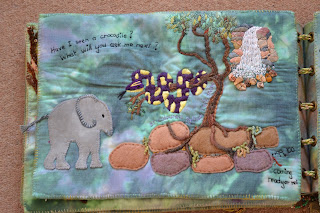The threads were first soaked in a soda/salt solution for about an hour. Skeins can be laid out in a litter tray. The plastic bottles need to be filled with water to weight them down in the plastic bowl. Pack as many bottles into the bowl as possible as this will reduce the amount of soda solution you need to fill the container. Make sure that the threads are fully immersed.
I mix my dyes up in jam jars and then pour out small amounts into plastic pots. The dye in these pots will become contaminated with soda salt solution as I dip my paint brush in and out so that any dye left over will not be able to be reused. The dye in the jam jars however can be stored somewhere cool, such as a garage, and will keep for use at a later date.
1/4 inch and 1/2 inch brushes are ideal for painting the dye onto the threads. The colours can be painted on in stripes or completely randomly. Garden gravel trays are great for standing your dyes and threads in. (helps contain any spillages)
Skeins can be laid flat in the bottom of these trays and several threads painted together.
I use thin plastic bags to cover each painted thread bottle and cut long pieces of plastic from rubbish sacks to wrap the skeins, several at a time.
These are then rolled up and put into a container
All the threads are left over night before I rinse them well using first cold water and then warm water with a few drops of synthrapol rinsing detergent (if you don't have any, use washing up detergent instead). Finally they are rinsed until no more dye is being lost. The threads on the bottles remain on the bottles for the whole process which will stop some of those terrible tangles.
Finally the threads can be hung up to dry. These garden tags are really useful for attaching the bottles and hangers to the washing line. Not sure what the neighbours think about our strange washing!
For this batch of threads, which were mostly different weights of silks, I used emerald green, lime green, forest green, bright yellow and a medium blue.
These were the thicker threads which I will store on the hanger for now.
These are a very fine mulberry silk which I can use for hand stitching or machine stitching so I like to wind some onto cotton reels to use straight on the sewing machine.
These are slightly thicker mulberry silk - great for hand stitching but can also be used in the spool on the sewing machine.
These are some threads I dyed a couple of weeks ago, using up various odds and ends of dye which I had stored for some time, so a complete mixture of colours.






























